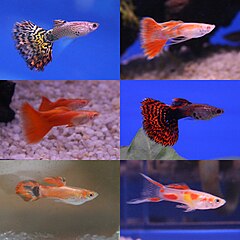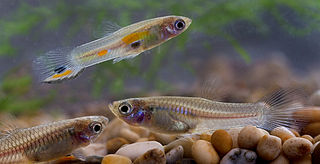A fascinating study at the University of Western Australia has shown that male Guppies (Poecilia reticulata) specifically choose drab-colored “friends” in order to improve their own attractiveness to females. What’s more, the behavior is not instinctive, but rather seems to be learned through experience (via “broken hearts”, I wonder!). This is the first time that any animal has been shown to choose a social group based upon the physical attractiveness of its members.
For Guppies, Appearance is Everything
Female Guppies choose mates based on the brightness of their coloration, with orange being most favored. Researchers presented male Guppies with the choice of 2 groups with which to associate. One group was comprised of a female and numerous drab-colored males, the other a female and attractive males (orange spots covering more than 20% of their bodies).
The test males chose to associate with the drab-colored group. Drab test males were more likely to pay attention to the attractiveness of their male associates. Very attractive male Guppies, it seems, need not worry about such details, as they were “confident” of their abilities to attract a mate regardless of the competition!
Yes, Fish can Learn!
The study, published in the Proceedings of the Royal Society B (V. 280, N. 1756), also confirmed what many aquarists have long suspected – fish can learn and profit from past experiences. Male Guppies raised in isolation from other males exhibited no preferences when given the choice of drab or colorful male associates. Researchers theorize that male Guppies learn to associate with drab companions based on their past mating successes…or failures, as the case may be! Please see the articles linked under “Further Reading” for more on fish intelligence.
Try This at Home
I’ve been able to observe the importance of male coloration in my own aquariums. I have long-established schools of “feeder” (wild type) Guppies in several tanks. Every so often I’ll add a large “fancy” male. Over the next several weeks, that male’s coloration, color patterns and/or fin structure will become very noticeable in the population, despite the fact that there may be 20-40 other males present. Please post your own observations below, thanks.
Deceitful Bullfrogs
American Bullfrogs exhibit a unique variation of this breeding strategy. Females select mates based upon the sound of the males’ calls, opting to hone in on those made by the largest males. Small males, who seem to know that they cannot attract a mate with their feeble songs, also listen for large males. Known as “satellite males”, the little fellows position themselves at the edge of a dominant male’s territory…far enough from him so as not to be attacked.
From this location they attempt to latch onto females that are swimming in to consort with the larger male. If successful, the satellite male steers his prize away from the larger male’s territory, in hopes of fertilizing the eggs that she is carrying. Although such trickery seems a bit under-handed, it is a good example of the “brains over brawn” concept!
Further Reading
Fish Intelligence: Experiments You can do at Home
 That Fish Blog – Aquarium Advice and Information
That Fish Blog – Aquarium Advice and Information




